
The Flag of the Department of Valle del Cauca is the representative flag of the Colombian Department of Valle del Cauca.

The Flag of the Department of Valle del Cauca is the representative flag of the Colombian Department of Valle del Cauca.
The origin of the flag is attributed to General José María Cabal who was in charge of the independentist forces in Valle del Cauca and who in a dream saw virgin Mary wearing a celestial blue and white mantle. The flag was used on June 6, 1811 by the confederate cities of Anserma, Buga, Cali, Caloto, Cartago, Iscuandé, Popayán and Toro when these declared independence from the rest of the country.
It was officially adopted on December 31, 1960 by the Department Assembly of Valle del Cauca.
The flag and its significance has generated controversy in Valle del Cauca for its pallid colors and for its religious connotation (Colombia self-proclaimed secularity in the Colombian Constitution of 1991). The flag was adopted by ordinance and not by popular plebiscite, as some argue the colors also misrepresented the people and things of Valle del Cauca. Painter Omar Rayo proposed the use of the colors of the Colombian flag adding the green color, which would represent the greenery of the department. [1]
The flag is composed by two parallel horizontal stripes of the same size one white and the other of a celestial blue and with a silver border.
The flag is flown in every official building of Valle del Cauca and the official events the governor or any of the municipal mayor are present. The flag is flown also by the flag of Colombia.

The flag of Chile consists of two equal-height horizontal bands of white and red, with a blue square the same height as the white band in the canton, which bears a white five-pointed star in the center. It was adopted on 18 October 1817. The Chilean flag is also known in Spanish as La Estrella Solitaria.

Cartago is a city in southwestern Colombia, about 187 miles (301 km) west of Bogotá. It is in the extreme northern portion of the Valle del Cauca Department. It is located very close to the city of Pereira, about a 20-minute drive. It is the sixth largest city in Valle after Cali, Palmira, Buenaventura, Tuluá and Jamundí. Per the 2018 Colombian census, Cartago's population was 118,803, a decrease from 121,741 per the Censo de Colombia de 2005.

Santiago de Cali, or Cali, is the capital of the Valle del Cauca department, and the most populous city in southwest Colombia, with 2,227,642 residents according to the 2018 census. The city spans 560.3 km2 (216.3 sq mi) with 120.9 km2 (46.7 sq mi) of urban area, making Cali the second-largest city in the country by area and the third most populous after Bogotá and Medellín. As the only major Colombian city with access to the Pacific Coast, Cali is the main urban and economic center in the south of the country, and has one of Colombia's fastest-growing economies. The city was founded on 25 July 1536 by the Spanish explorer Sebastian Belalcazar.

The national flag of Colombia symbolises Colombian independence from Spain, gained on 20 July 1810. It is a horizontal tricolor of yellow, blue and red. The yellow stripe takes up a half of the flag and the blue and red take up a quarter of the space each.

The national flag of Ecuador, which consists of horizontal bands of yellow, blue and red, was first adopted by law in 1835 and later on 26 September 1860. The design of the current flag was finalized in 1900 with the addition of the coat of arms in the center of the flag. Before using the yellow, blue and red tricolor, Ecuador's former flag had three light blue stripes and two white stripes with three white stars for each province of the country.The design of the flag is very similar to those of Colombia and Venezuela, which are also former constituent territories of Gran Colombia. All three are based on a proposal by Venezuelan General Francisco de Miranda, which was adopted by Venezuela in 1811 and later Gran Colombia with some modifications. There is a variant of the flag that does not contain the coat of arms that is used by the merchant marine. This flag matches Colombia's in every aspect, but Colombia uses a different design when her merchant marine ships are at sail. Along with Haiti, the Dominican Republic and El Salvador, it is one of only four national flags whose design incorporates a depiction of the flag itself.

The flag of Panama was made by María de la Ossa de Amador and was officially adopted by the "ley 48 de 1925". The Panamanian flag day is celebrated on November 4, one day after Panamanian separation from Colombia, and is one of a series of holidays celebrated in November known as the Fiestas Patrias.
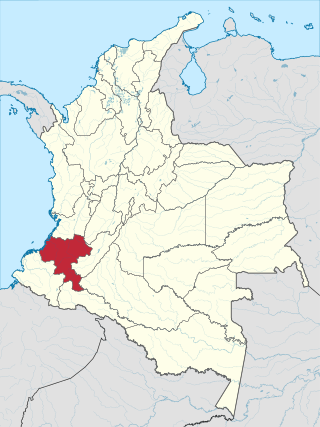
Cauca Department is a Department of Southwestern Colombia. Located in the southwestern part of the country, facing the Pacific Ocean to the west, the Valle del Cauca Department to the north, Tolima Department to the northeast, Huila Department to the east, and Nariño Department to the south. Putumayo and Caqueta Departments border the southeast portion of Cauca Department as well. It covers a total area of 29,308 km2 (11,316 sq mi), the 13th largest in Colombia. Its capital is the city of Popayán. The offshore island of Malpelo belongs to the department. It is located in the southwest of the country, mainly in the Andean and Pacific regions plus a tiny part (Piamonte) in the Amazonian region. The area includes 2.56% of the country.
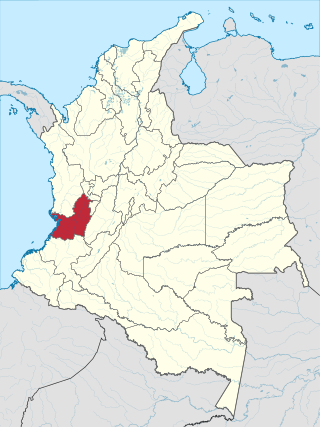
Valle del Cauca, or Cauca Valley, is a department in western Colombia abutting the Pacific Ocean. Its capital is Santiago de Cali. Other cities such as Buenaventura, Buga, Cartago, Palmira and Tuluá have great economical, political, social and cultural influence on the department's life. Valle del Cauca has the largest number of independent towns with over 100,000 inhabitants in the country, counting six within its borders. Buenaventura has the largest and busiest seaport in Colombia, moving about 8,500,000 tons of merchandise annually.
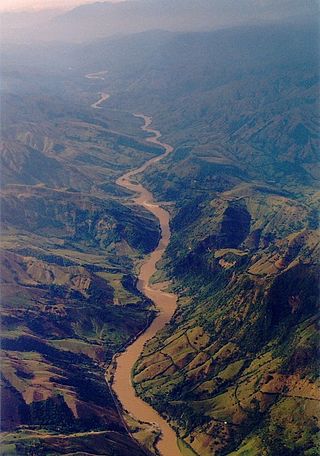
The Cauca River is a river in Colombia that lies between the Occidental and Central cordilleras. From its headwaters in southwestern Colombia near the city of Popayán, it joins the Magdalena River near Magangue in Bolivar Department, and the combined river eventually flows out into the Caribbean Sea. It has a length of 965 km (600 mi) to its junction with the Magdalena, for a total length of 1,350 km (840 mi). from origin to sea mouth. The river is under the supervision of the Cauca Regional Corporation and the Cauca Valley Regional Autonomous Corporation, and is navigable for 640 km (400 mi) above its junction with the Magdalena.

Palmira is a city and municipality in southwestern Colombia in the Valle del Cauca Department, located about 27 kilometres (17 mi) east from Cali, the department's capital and main city in the South of Colombia. Palmira is the second largest city in the Valle del Cauca, behind Cali.

The Valle del Cauca Deputies hostage crisis refers to the kidnapping of 12 Deputies of the Assembly of Valle del Cauca, Colombia, on April 12, 2002 by members of the Revolutionary Armed Forces of Colombia (FARC) to pressure a prisoner exchange between them and the government and to negotiate the demilitarization of the municipalities of Florida and Pradera to initiate peace dialogues.

Colombian Spanish is a grouping of the varieties of Spanish spoken in Colombia. The term is of more geographical than linguistic relevance, since the dialects spoken in the various regions of Colombia are quite diverse. The speech of the northern coastal area tends to exhibit phonological innovations typical of Caribbean Spanish, while highland varieties have been historically more conservative. The Caro and Cuervo Institute in Bogotá is the main institution in Colombia to promote the scholarly study of the language and literature of both Colombia and the rest of Spanish America. The educated speech of Bogotá, a generally conservative variety of Spanish, has high popular prestige among Spanish-speakers throughout the Americas.
The Department Assembly of Valle del Cauca is the department assembly of the Colombian Valle del Cauca Department. The assembly is part of the Colombian legislative branch of government at a Provincial level and its main function is to debate, approve or change the local ordinances.
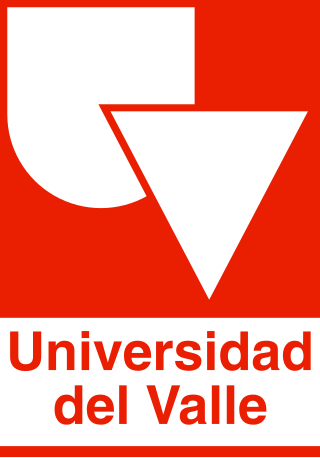
The University of Valle, also called Univalle, is a public, departmental, coeducational, research university based primarily in the city of Cali, Valle del Cauca, Colombia. It is the largest higher education institution by student population in the southwest of the country, and the third in Colombia, with more than 30,000 students. The university was established by ordinance No. 12 of 1945, by the Departmental Assembly as the Industrial University of Valle del Cauca, under the leadership of Tulio Ramírez Rojas and Severo Reyes Gamboa.

Dilian Francisca Toro Torres is a Colombian physician and politician, she served as Senator of Colombia from 2002 to 2013. She was investigated by the Supreme Court of Justice of Colombia on charges of money laundering, and remained under preventive detention from 25 July 2012 to 1 August 2013 at the Police Centre for Higher Studies (Cespo) in Bogotá. She currently serves as Governor of Valle del Cauca Department.

The national flag of Mexico is a vertical tricolor of green, white, and red with the national coat of arms charged in the center of the white stripe. While the meaning of the colors has changed over time, these three colors were adopted by Mexico following independence from Spain during the country's War of Independence, and subsequent First Mexican Empire.
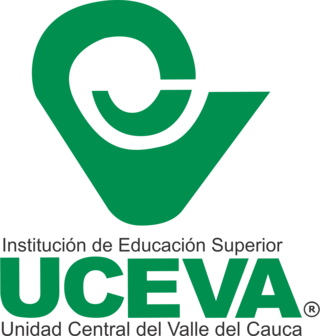
The Central Unit of Valle del Cauca, also called UCEVA, is a public, departmental, coeducational university based in the city of Tuluá, Valle del Cauca, Colombia.

Jhon Jairo Culma, sometimes spelled as John Jairo Culma, is a Colombian former footballer who played as a defensive midfielder.

The flag of Puerto Rico represents and symbolizes Puerto Rico and its people.
Guillermina Bravo Montaño is a Colombian teacher and politician of the Independent Movement of Absolute Renovation (MIRA) party. Currently she is a member of the Chamber of Representatives of Colombia. She was Deputy of the Department Assembly of Valle del Cauca from 2008 to 2011.